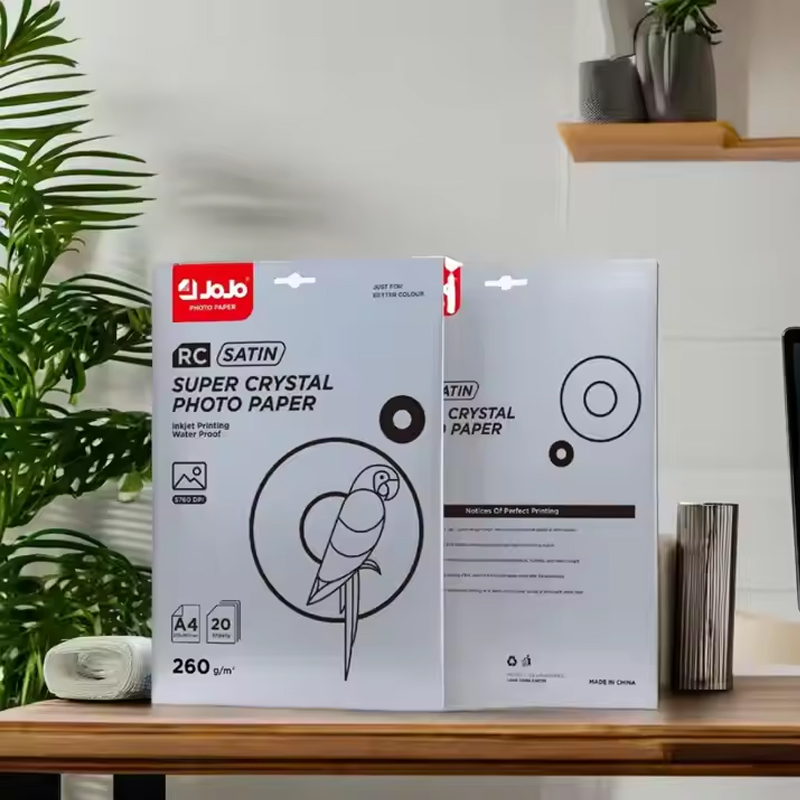If you need any help, please feel free to contact us
How to Choose the Right Inkjet Paper
Selecting suitable inkjet photo paper is an important step for anyone who wants to produce vivid prints, whether for personal photography, professional marketing materials, or other creative projects. With many options available, understanding the characteristics of different papers can help you make informed choices that fit your printer, ink, and specific goals. This article explores key considerations to guide you through the process, using Jojo Photo Paper as an example of modern inkjet paper solutions.

Understanding Paper Finish Types
One of the first factors to evaluate is the finish of the inkjet photo paper. The most common finishes include gloss, semi-gloss, satin, and matte. Each finish provides a different look and feel:glossy paper typically produces vibrant colors and higher contrast, making it suitable for photos with a lot of detail and bright tones. However, it can show fingerprints and reflections;matte paper has a smooth, non-reflective surface that works well for images that require a softer appearance. It is also preferred for documents or prints that will be handled frequently;satin or semi-gloss finishes offer a balance between shine and subtlety, delivering good color depth while reducing glare.
Jojo Photo Paper is available in multiple finishes, which enables you to match the paper type to the nature of each project.
Evaluating Weight and Thickness
Paper weight and thickness contribute significantly to the perceived quality of a print. Heavier papers (typically measured in grams per square meter, or gsm) tend to feel sturdier and are less likely to curl. For photography, papers ranging from 200 gsm to 300 gsm are often recommended, as they provide a substantial feel and support high ink loads without warping.
Before selecting a specific weight, check your printer’s specifications. Not every desktop inkjet printer is designed to handle heavier media, so confirming compatibility helps avoid paper jams or feed issues.
Considering Ink Compatibility
Inkjet photo papers are formulated to absorb and retain ink without smudging or bleeding. Jojo Photo Paper is engineered to work with water-based dye inks commonly used in Epson, HP, and Canon printers. This compatibility is crucial because different coatings on the paper surface interact uniquely with pigment-based or dye-based inks.
If you use dye ink, look for papers with microporous coatings that enable faster drying and help maintain color accuracy. Pigment inks may require papers with specialized coatings to enhance longevity and water resistance. Reviewing your printer and ink combination will make it easier to choose an appropriate product.
Assessing Color Reproduction and Brightness
Paper brightness (often referred to as whiteness) affects how colors appear after printing. Brighter papers can make colors look more vivid, while warmer-toned papers may slightly soften color intensity. Jojo Photo Paper uses high-quality base materials designed to showcase a wide color gamut and maintain image clarity.
When evaluating papers, consider printing a test image that includes a range of tones, from deep shadows to bright highlights. This comparison allows you to see how a specific paper influences the final result.
Drying Time and Handling
Another practical consideration is drying time. Papers that dry quickly reduce the risk of smudging when handling freshly printed images. If you produce large quantities of prints or need to package them soon after printing, faster drying can improve productivity.
Jojo Photo Paper features a coating designed to promote efficient drying without sacrificing sharpness or saturation. This characteristic supports smoother workflows in busy environments.
Storage and Longevity
For projects that must last over time, such as photo albums or displays, consider archival qualities. While some papers include treatments that increase resistance to fading or yellowing, it is also important to store prints away from direct sunlight, high humidity, or extreme temperatures.
Even with protective coatings, environmental conditions strongly affect the longevity of inkjet prints. Using acid-free storage materials and maintaining moderate conditions will help preserve image quality.
Matching Paper to Project Requirements
Choosing the right inkjet photo paper is not only about technical compatibility but also about the intended purpose of your prints. For example:professional photographers may prefer heavyweight glossy papers for portfolio images;marketing teams might select satin finishes that minimize glare during presentations;hobbyists could find matte papers better for crafting or scrapbooking.
Because Jojo Photo Paper comes in various weights and finishes, it can be adapted to diverse needs without requiring different brands or suppliers.
Selecting inkjet photo paper involves more than picking the first product that claims broad compatibility. Taking the time to understand finish types, weight, ink compatibility, and drying characteristics will help you produce prints that meet your expectations for color accuracy and durability.
Jojo Photo Paper offers a practical combination of options designed to work well with leading inkjet printers and water-based dye inks. By evaluating your specific project requirements and testing samples when possible, you can identify the right paper to achieve consistent, high-quality results across your printing tasks.

 English
English Español
Español 中文简体
中文简体 Português
Português

